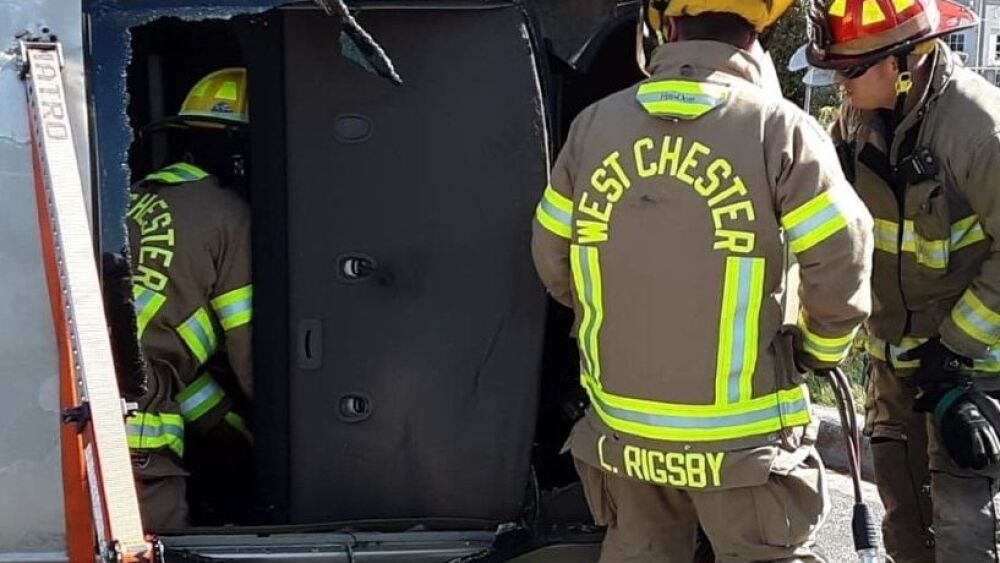By Ron Shaw
There’s a number of rescue equipment systems and extrication tools, cutters and spreaders available to fire departments. Deciding which tools and systems will best serve your agency is based on a number of factors.
Extrication tool and system types
Each heavy rescue tool system available has its own unique benefits. and no one tool is best for every situation. Options include:
- Electric (battery-powered electric motor system)
- Electric-hydraulic (battery-powered hydraulic system)
- Hydraulic system
- Manual-operated hydraulic hand pump
- Electric hard wire motor-driven hydraulic pump
- Internal combustion engine driven
- Power Take-Off (PTO)-driven hydraulic pump
Some points to note about these systems:
Pros and cons: Each of these extrication systems may have an advantage over the other in a given situation. For example, a crash on a mountainside that requires responders to backpack the equipment is not feasible for a PTO system, as its hoselines would not be extended beyond 100 feet. Conversely, if the crash was in a city, having a unit with a PTO power unit with 100-foot reels and pre-attached tools that can be put into immediate operation is desirable. For an agency that has both off-road and urban crashes, having a lightweight portable power unit and combination tool may be the best system for them.
Money matters: Economics also plays an important part. If your department has an unlimited budget, dedicated extrication tools will outperform a combination tool in both cutting and spreading/pulling forces. For a smaller community with limited funds, choosing tools that serve a dual role, such as a combination tool, would be an option to consider. For example, having a spreader with 42-inch arms is more costly than standard (28-32 inch) length arms. However, having such a tool would be an overall saving when contemplating purchasing a large dedicated spreader, and ram (small, medium and large) set. If your apparatus has limited cabinet space, a more compact tool may be more desirable.
Purchase committee: A proactive department will form a committee that will include members of the organization who will actually be using the tools. In my opinion, whenever possible, personnel that will be using the tools should be consulted, and have a direct say during the equipment selection process. In situations when the end-user is not consulted during the selection process, there is a greater chance for personnel to be disgruntled. Once you have your purchasing committee established, it’s time to prepare to talk sales.
Working with extrication tool and system sales reps
Buyers are often persuaded by dealer sales representatives. While their suggestions may be well-intended, they may not know your department’s specific needs or requirements. This is something the end-user will know. And the tool choice may not best serve your department’s needs when outside opinions are accepted without any other considerations being made.
There are several key questions your committee should pose to sales representatives:
- What type of warranty do you offer?
- Conditions of coverage
- One-year
- Lifetime
- What are the tool service recommendations?
- Weekly operator inspection recommendations
- Monthly operator inspection recommendations
- Yearly vendor inspection and service requirements
- What is the vendor commitment?
- Loaner tools
- Technician repair response time
- Is the tool compatible with our other systems or tools?
- Will you be able to add on tools utilizing the existing system regardless of make and operating pressure (5,000-10,000 PSI) for old and new tool systems?
- What key tasks and functions do the tools provide?
- Are the tools compatible for modern vehicle construction and able to cut metals, such as boron steel used in many late-model vehicles?
- Are your tools ergonomically designed (weight optimization) for user comfort and balance?
Choosing the right tools
Once you have the answers you need, it’s time to select the right tools for your department. Make these decisions based on the following influences (and others that apply to your department’s specific needs):
- General compatibility with the existing system
- Purpose of heavy rescue tools (extrication on/off-road and/or breaching)
- Physicality of team members
- Rescue types
It should be pointed out that no agency can efficiently perform extrication solely with heavy rescue tools alone.
Most agencies don’t like to switch between rescue tools unless there is total compatibility with existing and new tools, or the total system (power unit and rescue tools) has served its useful purpose and money would better be spent in replacement than repairs.
Having a rescue tool system that is generic allows your current inventory of tools to be replaced gradually, so not to tax your department’s tool replacement budget. By adding on to the existing system, your department can gradually replace older, obsolete tools as required. This would be a more cost-efficient method of tool procurement/replacement.
It should also be noted that there are many manual and power tools that are also required for rescue work. Consideration for hand/power tools should be addressed prior to purchasing the heavy hydraulics. One of the least used, yet most versatile, extrication tools is a quality reciprocating saw. Often, this single tool with the proper blade can outperform a dedicated heavy rescue tool. When used together with heavy rescue tools, they will efficiently expedite a modern vehicle rescue.
Having the right power tools, such as a quality reciprocating saw, may influence your heavy rescue tool purchase. If you have a saw that can do the same job as a dedicated cutter, you may be able to channel funds for another type of tool that.
Sample extrication tool setups
Let’s now consider some extrication tool setups that would work for various agencies.
Small agency: For a small agency or one that works off a mobile platform for rescue work, the following tool setup would be ideal:
- One internal combustion engine “mini” power unit capable of powering all selected tools, having flat face connectors and providing power to two tools.
- Two 30-foot hydraulic hoselines (each identified by separate color coding), having flat face connectors.
- One combination tool (spreader/cutter) with removable tips and flat face connectors.
Another option:
- Battery-powered power unit (backpack) having a minimum of 20 minutes of operation with two spare batteries and a charging system. Connectors are an option based on needs and limitations of your agency.
- One combination tool (spreader/cutter) with removable tips and flat face connectors. Military units may want the tool with fixed lines instead of quick disconnect couplers.
Medium agency: For a small to medium size township, the following are my minimum recommendations for heavy rescue tools:
- One mini power unit capable of powering all selected tools, having flat face connectors, providing power to two tools.
- Two 30-foot hydraulic hoselines (each identified by separate color coding), having flat face connectors.
- Large dedicated spreader, with flat face connectors.
- Large dedicated cutter (capable of cutting boron steel structural components) with flat face connectors.
- Medium ram with flat face connectors.
- 1.5 gallons of hydraulic fluid, or recommended quantity.
Larger agencies: For departments with the resources, a combination tool (capable of cutting exotic metals, such as boron steel) is highly suggested. Combination tools are well suited for a crash that only needs a door displacement or simple cuts to a structural member.
Combination tools provide spreading, crushing and cutting functions. Those with removable tips can increase the cutting capabilities by providing full cuts without the tips impeding the cut. Combination tools also cause less fatigue to the user, especially if they don’t have the upper body strength to support a large dedicated tool.
Bonus Resource
How to buy extrication tools (eBook)
Download this FireRescue1 extrication tools buying guide to learn key steps for product selection, purchasing and implementation
Any other suggestions? Anything we missed in the list above? Leave a comment below or e-mail editor@firerescue1.com with your feedback.
Editor’s note: This article was originally published in 2009. It has been updated.
About the author
Ron Shaw was a career fire service lieutenant with more than 29 years of service.














